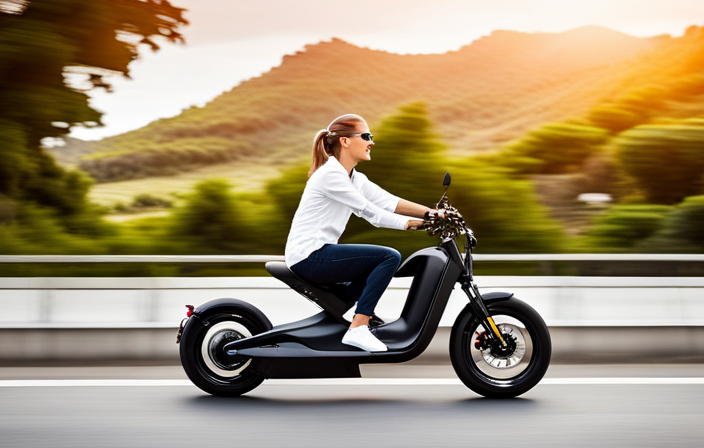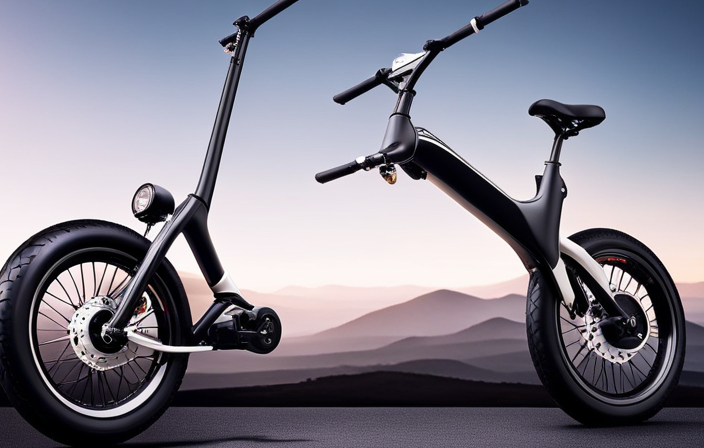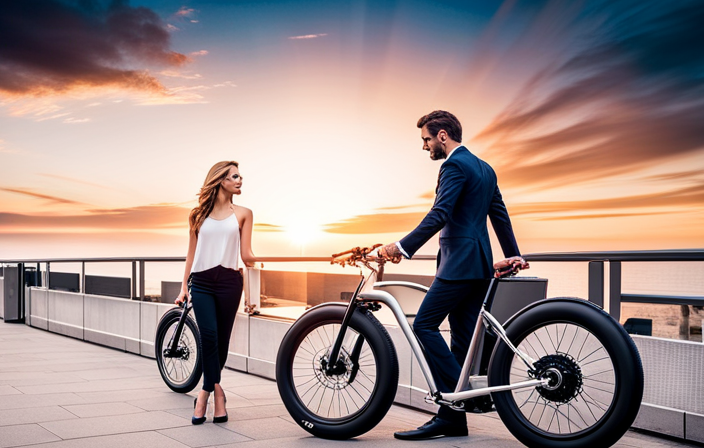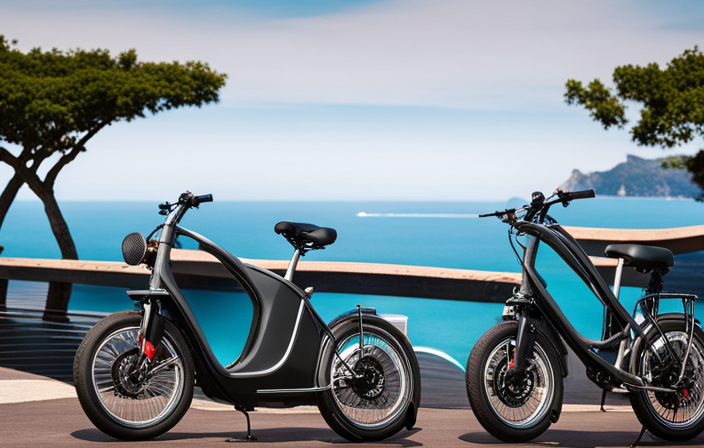As the world embraces sustainable transportation options, one question on the minds of many potential electric bike owners is, ‘How many miles can an electric bike go on one charge?’
Like unlocking a hidden path, this article will guide you through the factors that influence electric bike range, from pedal assist modes to battery management.
By the end, you’ll have the knowledge to choose the perfect electric bike and explore the open road with confidence.
Let’s dive in and uncover the secrets of electric bike range.
Key Takeaways
- Motor power and battery capacity are key factors that determine the distance an electric bike can travel on one charge.
- Factors such as terrain, rider weight, and wind resistance also impact the mileage of an electric bike.
- Customizable pedal assist modes and levels allow riders to balance assistance and battery life to maximize the bike’s range.
- Efficient riding techniques, such as maintaining a steady speed and using pedal assist wisely, can help extend the electric bike’s range.
Factors Affecting Electric Bike Range
You’ll want to consider several factors that can affect how far an electric bike can go on one charge.
Understanding motor power is essential in determining the range of an electric bike. The higher the motor power, the more energy it consumes, which can reduce the mileage.
Additionally, optimizing battery capacity plays a vital role in determining the distance an electric bike can travel. A larger battery capacity generally means a longer range.
However, it’s important to note that other factors such as terrain, rider weight, and wind resistance can also impact the mileage.
Now, let’s move on to understanding pedal assist modes, which further enhance the electric bike’s range and performance.
Understanding Pedal Assist Modes
When it comes to understanding pedal assist modes on electric bikes, there are a few key points to consider.
First, different levels of assistance can be selected depending on the rider’s preference and needs. This allows for a customizable riding experience, whether you want a little boost or a lot.
Second, it’s important to understand that the level of assistance chosen can impact the battery life of the electric bike. Higher levels of assistance will drain the battery faster, while lower levels will conserve energy and extend the range.
So, it’s important to find a balance that suits your riding style and desired distance.
Different Levels of Assistance
There’s a difference in how far an electric bike can go on one charge depending on the level of assistance. Understanding power modes is crucial in determining the impact on performance.
Electric bikes typically have different levels of assistance, ranging from low to high. The lower the assistance level, the more you have to pedal to achieve higher speeds. This means that the battery will last longer, allowing you to cover more miles on a single charge.
On the other hand, higher levels of assistance provide more power, allowing you to reach higher speeds with less effort. However, this also means that the battery will drain faster, reducing the overall distance you can travel.
Therefore, it’s important to find the right balance between assistance and battery life to optimize your electric bike’s range.
Impact on Battery Life
The level of assistance on an e-bike has a direct impact on how long the battery will last. When using a higher level of assistance, such as a higher power mode or a higher level of pedal assist, the battery will drain faster than when using a lower level of assistance. This is because more power is being drawn from the battery to provide the extra assistance.
The battery capacity of an e-bike is an important factor to consider when determining how far it can go on one charge. A larger battery capacity will generally allow for a longer range.
Additionally, the availability of charging infrastructure, such as charging stations or the ability to charge at home, can also impact the battery life of an e-bike.
With these factors in mind, let’s explore range testing and estimation.
Range Testing and Estimation
Range testing and estimation are crucial in understanding the capabilities of an electric bike. There are a few different approaches to range testing. One common method is to fully charge the battery and ride the bike on a predetermined route until it runs out of power. This test provides an estimate of the bike’s range. Estimating battery capacity is also important. Factors such as the battery’s voltage and ampere-hour rating can be considered to calculate an approximate range.
Moving forward, it is essential to consider battery management and maintenance for optimal performance and longevity.
Battery Management and Maintenance
To ensure optimal performance and longevity, it is important to properly manage and maintain the battery of an electric bicycle. Here are three battery management tips that will help you get the most out of your electric bike:
-
Use the right charging methods: Charging your electric bike battery correctly is crucial for its overall health. Follow the manufacturer’s guidelines and use the recommended charger. Avoid overcharging or leaving the battery completely drained for extended periods.
-
Troubleshoot common battery issues: If you encounter any problems with your electric bike battery, there are a few common issues you can troubleshoot. Check the connections, clean the terminals, and ensure the battery is securely mounted. If the problem persists, consult a professional.
-
Maintain proper storage: When not in use, it’s important to store your electric bike battery in a cool and dry place. Extreme temperatures can negatively impact its performance and lifespan.
By following these battery management practices, you can maximize the range and lifespan of your electric bike. When choosing the right electric bike for your needs, it’s essential to consider factors such as power, range, and terrain compatibility.
Choosing the Right Electric Bike for Your Needs
When selecting the perfect electric bicycle for your requirements, it’s crucial to consider factors such as power, terrain compatibility, and desired range.
Understanding motor power is essential as it determines the bike’s performance and ability to handle different terrains. A more powerful motor will provide better acceleration and hill-climbing capabilities.
Additionally, choosing the right battery is vital for maximizing your electric bike’s range. Lithium-ion batteries are the most common choice due to their high energy density and longer lifespan. Consider the battery’s capacity, which is measured in watt-hours (Wh), as it directly impacts the distance you can travel on a single charge.
It’s important to find the right balance between power and range to ensure your electric bike meets your needs.
Maximizing Your Electric Bike’s Range
When it comes to maximizing the range of my electric bike, I have found that efficient riding techniques play a crucial role. By maintaining a steady speed and avoiding sudden accelerations or braking, I am able to conserve battery power and go further on a single charge.
Additionally, using pedal assist wisely allows me to strike the perfect balance between using my own energy and relying on the electric motor, further extending the bike’s range.
Lastly, planning my routes in advance helps me avoid unnecessary detours or steep inclines, ensuring that I can make the most of my electric bike’s range.
Efficient Riding Techniques
You can maximize the mileage of your electric bike by using efficient riding techniques. One way to do this is by using efficient pedaling techniques. This means pedaling smoothly and evenly, without putting too much strain on the motor. By doing so, you can reduce the amount of power the motor needs to provide and extend the range of your electric bike.
Another technique to consider is reducing wind resistance. Riding in a more aerodynamic position, such as leaning forward and tucking in your elbows, can help you cut through the wind more efficiently and conserve battery power.
By implementing these efficient riding techniques, you can extend the range of your electric bike and get the most out of each charge.
Now, let’s move on to the next section about using pedal assist wisely.
Using Pedal Assist Wisely
To maximize the efficiency of your electric bike, it’s important to use pedal assist wisely. Pedal assist is a great feature that can help you optimize power usage and extend the distance you can go on one charge. By understanding how to use it effectively, you can make the most out of your electric bike.
One way to use pedal assist wisely is to adjust the level according to your needs. Using a lower level when riding on flat terrain or downhill can conserve battery power, while a higher level can be used for uphill climbs or when you need an extra boost.
Another important aspect is to find the right balance between pedal power and electric power. Using pedal assist doesn’t mean you have to stop pedaling altogether. In fact, combining your pedaling with the electric power can help maximize efficiency and extend the battery life.
To emphasize these points, here’s a table that illustrates the relationship between pedal assist levels and power usage:
| Pedal Assist Level | Power Usage |
|---|---|
| Level 1 | Low |
| Level 2 | Moderate |
| Level 3 | High |
| Level 4 | Very High |
| Level 5 | Max |
By using pedal assist wisely and finding the right balance, you can maximize the efficiency of your electric bike and optimize power usage. Planning your routes based on terrain and distance is the next step to ensure you get the most out of your electric bike without running out of charge.
Planning Your Routes
Planning your routes is essential for maximizing the efficiency of your e-bike and getting the most out of it. When it comes to route planning, there are a few key factors to consider.
Firstly, it’s important to choose routes that are suitable for electric bikes, such as those with bike lanes or low traffic volume. This not only ensures a safer ride but also helps to conserve battery power.
Additionally, taking advantage of charging infrastructure along your route can greatly extend the distance you can travel on a single charge. Research and plan your stops accordingly to make use of public charging stations or other available options.
By carefully planning your routes and considering charging infrastructure, you can optimize your e-bike’s range and enjoy longer rides without worrying about running out of power.
However, there are additional factors to consider when it comes to maximizing your e-bike’s mileage.
Additional Factors to Consider
When it comes to maximizing your electric bike’s range, there are a few additional factors to consider.
First, weather conditions play a significant role in how far your bike can go on a single charge. Strong headwinds or extreme temperatures can significantly reduce your battery life.
Second, paying attention to tire pressure and rolling resistance can make a difference. Keeping your tires properly inflated and choosing tires with low rolling resistance can help you go the extra mile.
Lastly, the accessories and attachments you add to your electric bike can also impact its range. Things like panniers, baskets, or even a child seat can add weight and increase wind resistance, ultimately reducing your battery life.
Weather Conditions
On a sunny day, you can expect your electric bike to go for quite a few miles on one charge. However, it’s important to consider the weather conditions when estimating the range of your electric bike. Harsh weather conditions such as rain, strong winds, or extreme temperatures can significantly affect the battery life and reduce the distance you can travel.
To ensure a longer range, it’s advisable to wear appropriate protective gear, such as a helmet and reflective clothing, in case of unexpected weather changes. Additionally, regular maintenance is crucial for optimal performance. Keeping your bike clean, checking the tire pressure, and lubricating the chain can all help improve efficiency and extend the battery life.
Speaking of tire pressure and rolling resistance, let’s delve into how these factors can impact your electric bike’s range.
Tire Pressure and Rolling Resistance
Maintaining proper tire pressure and reducing rolling resistance can help increase the range of your e-bike. By reducing friction and optimizing tire tread design, you can improve the efficiency of your electric bike and extend its battery life. One way to achieve this is by regularly checking and inflating your tires to the recommended pressure level. This ensures that your bike rolls smoothly and minimizes the energy wasted due to tire deformation. Additionally, choosing tires with a low rolling resistance can further enhance the performance and range of your e-bike. By reducing the effort required to propel your bike forward, you can conserve energy and go the extra mile. Taking these measures to minimize rolling resistance will allow you to maximize your e-bike’s range. In the next section, we will explore how accessories and attachments can impact the distance your electric bike can travel on a single charge.
Accessories and Attachments
To improve your e-bike’s range, consider adding accessories and attachments. There are various options available that can help increase your e-bike’s mileage.
One popular option is a pannier bag or basket. This allows you to carry extra batteries for longer rides. Another useful accessory is a solar charger. This can help recharge your e-bike’s battery while you’re on the go.
Additionally, proper maintenance is crucial for maximizing your e-bike’s range. Regularly check and inflate your tires to the recommended pressure. This can reduce rolling resistance and improve efficiency. It’s also important to keep your chain clean and lubricated. A well-maintained drivetrain can make a significant difference in your e-bike’s performance.
By utilizing these accessory options and following maintenance tips, you can extend your e-bike’s mileage.
Now, let’s explore some real-life examples of electric bike range.
Real-Life Examples of Electric Bike Range
If you ride an electric bike, you’ll be amazed at the real-life examples of how far they can go on one charge. Here are three impressive electric bike range comparisons that will make you reconsider your daily commute:
- The Rad Power Bikes RadRover can travel up to 45 miles on a single charge, perfect for longer rides or hilly terrains.
- The Ancheer Power Plus Electric Mountain Bike boasts a range of 30 miles, making it ideal for adventurous off-road trips.
- The Swagtron EB7 Plus Folding Electric Bike can go up to 20 miles on one charge, perfect for urban commutes or short errands.
To increase your electric bike’s range, try these tips:
- Maintain proper tire pressure for optimal efficiency.
- Use pedal-assist mode to conserve battery power.
- Avoid excessive weight on the bike, as it can drain the battery faster.
Now, let’s explore battery upgrades and range extenders to further extend your electric bike’s range.
Battery Upgrades and Range Extenders
Battery upgrades and range extenders are two options that can significantly increase the distance your electric bike can travel on a single charge. By upgrading to a higher capacity battery, you can store more energy and go further before needing to recharge. Some electric bike manufacturers offer battery upgrade options, allowing you to replace your current battery with a larger one. Additionally, range extenders can be added to your electric bike to supplement the battery’s power. These devices, such as secondary batteries or fuel cells, provide extra energy to extend your bike’s range. With battery upgrades and range extenders, electric bikes can potentially travel over 100 miles on a single charge. As technology continues to advance, we can expect even more impressive developments in electric bike range.
Future Developments in Electric Bike Range
Advancements in battery technology, industry trends, and innovations are all contributing to the future developments in electric bike range.
With the continuous improvement in battery technology, we can expect to see electric bikes with longer ranges on a single charge.
Additionally, industry trends and innovations, such as the use of lightweight materials and more efficient motors, will also play a significant role in enhancing the range of electric bikes.
Advancements in Battery Technology
You can easily travel longer distances on an electric bike due to recent improvements in battery technology. These advancements in battery technology have significantly increased the range of electric bikes, making them a viable option for longer commutes and recreational rides.
Here are three key factors contributing to the improved range:
-
Higher energy density: Battery technology has evolved to offer higher energy density, meaning that more energy can be stored in a smaller and lighter battery, allowing for longer rides without the need for frequent recharges.
-
Fast-charging capabilities: Modern electric bike batteries can be charged at a faster rate, reducing the time needed to recharge and enabling riders to cover more miles in a shorter amount of time.
-
Regenerative braking: Some electric bikes now feature regenerative braking technology, which converts kinetic energy during braking into electrical energy that can be used to power the bike. This feature not only increases the range but also improves the overall efficiency of the bike.
These advancements in battery technology have revolutionized the electric bike industry, paving the way for even greater innovations and industry trends.
Industry Trends and Innovations
To stay ahead of the game in the electric bike industry, it’s important to keep up with the latest industry trends and innovations. One important aspect of the industry is the development of industry standards for electric bike batteries. As technology advances, it is crucial for manufacturers to agree on standards that ensure compatibility and safety across different brands and models. This not only benefits consumers but also promotes healthy competition and innovation within the industry.
Another key trend in the electric bike industry is the development of charging infrastructure. As more people switch to electric bikes, the demand for convenient and reliable charging stations increases. Companies are investing in the installation of charging stations in urban areas, making it easier for riders to charge their bikes on the go. This development is essential for the widespread adoption of electric bikes and is expected to play a significant role in the future of transportation.
By keeping up with these industry trends and innovations, electric bike manufacturers can continue to improve their products and provide better experiences for riders.
Frequently Asked Questions
Can I use my electric bike in rainy or snowy weather?
When using electric bikes in extreme weather conditions like heavy rain or snow, it can impact the battery life and performance. Proper maintenance and care are required to ensure optimal performance in these conditions.
How long does it take to fully charge the battery of an electric bike?
It typically takes around 4-6 hours to fully charge the battery of an electric bike. The charging time may vary depending on the battery capacity and charger used. The battery life can last for several years with proper care and maintenance.
Are electric bikes safe to ride on hilly terrains?
Electric bikes are safe to ride on hilly terrains due to their powerful motors and ability to provide assistance while climbing. Electric bike capabilities make them ideal for tackling steep inclines with ease and without exerting excessive effort.
Can I ride my electric bike without using the pedal assist mode?
Yes, you can ride an electric bike without using the pedal assist mode. By using the throttle only, you can control the speed without pedaling. However, this may reduce the battery life compared to using pedal assist.
Are there any regulations or restrictions on the range of electric bikes in different countries or states?
Electric bike range regulations and restrictions vary worldwide. Laws differ between countries and states, dictating how far an electric bike can go on one charge. It’s important to research and understand these regulations to ensure compliance.
Conclusion
In conclusion, electric bikes have come a long way in terms of range and performance. With advancements in battery technology and efficient motor systems, electric bikes can now travel impressive distances on a single charge. Factors such as terrain, rider weight, and pedal assist modes play a role in determining the range of an electric bike.
It’s important to choose the right electric bike for your needs and properly manage and maintain the battery for optimal performance. Keep an eye out for future developments in electric bike range, as technology continues to improve.
So, hop on your e-bike and ride on, knowing you can go the extra mile!









